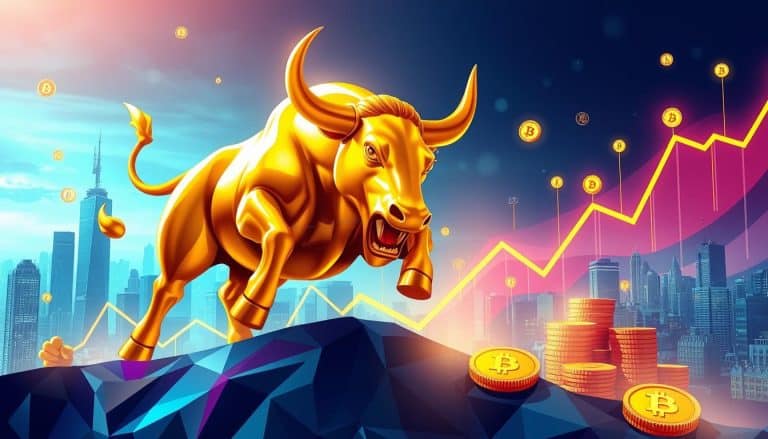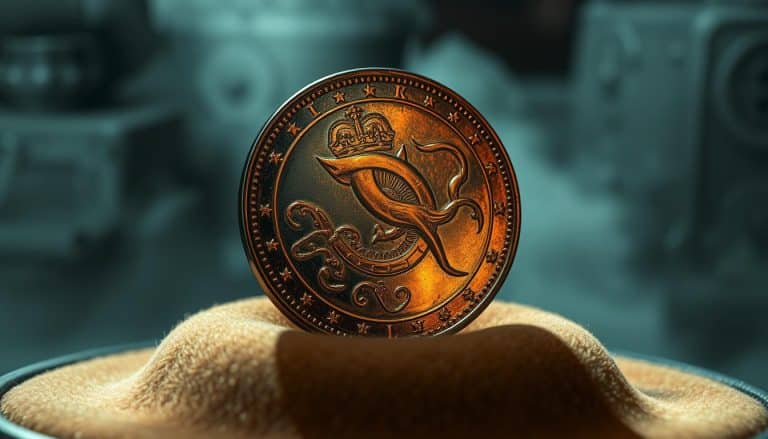Unlock Value with Real World Assets Investment
The market for tokenized assets might soar above USD 10 trillion by 2030. This is a huge jump, 40 times more than in 20221. Tokenized things like real estate and gold are getting really popular in the digital world2. These investments link to real stuff worth a lot of money, giving you a chance to dive into a new way of investing2.
It’s changing the old ways of investing because it’s clearer, you can sell faster, and more people can join in1. Getting into this area opens up a lot of value and brings a big change in how we invest.
Key Takeaways
- The market value for tokenized assets is projected to skyrocket, exceeding USD 10 trillion by 20301.
- Tokenized real-world assets bring hundreds of trillions of dollars in potential value to decentralized networks2.
- These asset-backed investments offer increased transparency and liquidity, making them appealing for diversified portfolios1.
- Real-world assets like real estate, precious metals, and art are quickly becoming part of the digital asset economy2.
- Tokenization democratizes ownership, allowing high-value assets to be divided into smaller, more accessible pieces2.
Introduction to Real World Assets Investment
Real World Assets (RWAs) include both tangible and physical items that are valuable in the real world. These assets are popular because they provide stable and tangible returns. Investing in them also protects against inflation and helps diversify your investment portfolio.
What Are Real World Assets?
Real world assets are tangible items or financial assets that are valuable in the real world. Examples include real estate, commodities, art, and intellectual property. These have a physical presence and value beyond just being digital. Through tokenization, digital tokens represent these assets on the blockchain, making investment easier34. This method allows for owning parts of an asset and improving its liquidity4. It’s changing how we invest in physical and tangible assets4.
Examples of Real World Assets
Real estate is a key real-world asset, including homes and business buildings. It provides rent income, selling opportunities, or can be used as collateral. Precious metals like gold and silver are also important for their consistent value4. Items such as art, antiques, and unique coins are valuable assets as well.
- Real Estate: Offers rental income, capital appreciation, and potential tax benefits.
- Precious Metals: Serve as a store of value and a hedge against economic instability.
- Commodities: Essential for various industries, including oil, gas, and minerals.
- Collectibles: Art, antiques, and rare coins provide both aesthetic and financial value.
- Agricultural Products: Key commodities that drive the farming sector and offer diverse investment opportunities4.
Tokenized assets connect the physical and digital, making investments more fluid and open34. This method makes investing clear and available to more people, including those new to crypto. It combines the safety and growth potential of physical assets with the digital world4.
The Benefits of Investing in Real World Assets
Investing in real world assets offers many advantages. It can make your investment mix safer and perform better. These gains come from blockchain technology and the real value of physical assets.
Enhanced Transparency
One key benefit of RWAs is better transparency, thanks to blockchain. Blockchain’s secure record-keeping makes every transaction clear and verifiable. This adds trust and security not easily found elsewhere. Big names like BlackRock and JPMorgan are using blockchain to enhance their operations5. This shows the trust in this technology.
Increased Liquidity
Managing real assets also boosts liquidity. Tokenizing lets high-value assets be split into smaller, tradable pieces. This opens the door to more investors. Tokenized RWAs mean many investors can buy shares of an asset6. This approach makes assets that are usually hard to sell more available. The market for tokenized RWAs hit $5 billion by December 2025. This shows more people are getting into this type of investment5.
Diversification Opportunities
RWAs offer great chances to diversify. They let you into asset classes that were hard to get into before. Adding RWAs like real estate, commodities, and art reduces risk and gives stable returns. Blockchain technologies ensure these transactions are efficient and safe5.
Your RWA investment strategy is more than saving money. It’s about using new FinTech that brings many financial benefits. With growth in tokenized assets and more companies joining in, RWAs are a key part of a good investment mix.
Understanding Tokenization of Real World Assets
Tokenization of real-world assets is changing how we look at ownership and investing. Assets like real estate, art, and commodities can now be digital tokens, thanks to blockchain technology. These digital tokens make owning and trading these assets easier and more accessible.
Definition and Basics
Asset tokenization means turning real-world assets into digital tokens that show who owns them. This is done through smart contracts on blockchain networks, making deals secure and clear. The blockchain keeps a permanent record of who owns and transfers these tokens7.
Turning assets into digital form makes investing open to more people. It also brings more activity and liquidity to the markets8.
How Tokenization Works
The process starts by picking an asset and checking its ownership. A digital token that represents the asset is then created. Smart contracts control this token, setting the rules for owning it. Lastly, these tokens are shared on blockchain platforms.
This method lets us divide assets into smaller, easily traded parts. This is called fractional ownership8.
| Tokenized Asset | Market Impact |
|---|---|
| Real Estate | Provides fractional ownership, increasing investment opportunities |
| Art & Collectibles | Enables fractional ownership and trading of high-value items |
| Commodities | Makes trading assets like gold and oil more accessible |
Tokenizing real-world assets is a big step forward in today’s digital world. It brings together blockchain and traditional assets. This creates new possibilities for liquidity, reach, and safety, changing how investors and asset managers operate798.
Key Benefits of Tokenized Real World Assets
Tokenizing real world assets brings key advantages for investors looking to use new market features. They get to own parts of big investments, reach them worldwide, and trade any time. This changes how investors approach the market today.
Fractional Ownership
With tokenization, owning a piece of high-value assets becomes easy. This includes things like houses, art, or other properties. It makes investing more open to everyone by needing less money to start. This way, selling and buying these assets becomes smoother10. Technologies like Ethereum and Stellar help break down the ownership10.
Global Accessibility
Tokenization also means people from different countries can invest easily. It uses blockchain to handle trades over borders smoothly. This shakes up old rules, letting investors globally try their hand at real world assets11. Sectors like real estate and finance are already seeing big changes, opening up new chances10.
24/7 Trading
Blockchains let trading happen all day and night. This gives investors a chance to trade when it fits their lives, no matter their time zone. Tools from platforms like Kaleido support this non-stop trading1011. Stellar has made reporting much quicker for things like Mortgage-Backed Securities, showing how fast blockchain can be12.
Here’s a nice table that shows these benefits on different platforms:
| Platform | Feature | Benefit |
|---|---|---|
| Ethereum | Fractional Ownership | Accessible investment in high-value assets |
| Hyperledger Fabric | Global Transactions | Seamless cross-border investments |
| Stellar | Efficient Reporting | Reduced processing times for assets |
Real World Assets Investment Strategies
Investing in Real World Assets (RWAs) offers a variety of strategies. These are based on your goals, risk level, and investment time. By using both long-term and short-term plans, you can better manage your assets.
Long-term Investment Plans
Long-term plans usually aim for the growth of assets like real estate. This suits those seeking steady wealth growth. Assets can be split into smaller parts for everyone to invest in13.
Companies like Koibanx and Realio make this easier by breaking down huge assets for all13. Some assets, like the St. Regis Aspen Resort, have gained a lot through token sales14. The money locked in RWAs shows their growing popularity for long-term investments15.
Short-term Trading Opportunities
Short-term trading shines with the ever-changing tokenized asset market. This lets you make quick moves for profit. With tokenization, a new trading world opens up, boosting liquidity14.
BNB Chain can handle many transactions fast and cheap, perfect for short-term trades15. Utilizing these features can boost your investment game and bring in big wins.
Mixing various Real World Asset strategies can spread out risk and add stability13. With both long-term and short-term methods, your investment strategy becomes stronger. For more info on these strategies, check decentralized finance investment strategies.
Real World Assets in the DeFi Ecosystem
Real World Assets (RWAs) are joining the DeFi world and opening new financial paths. They bring into play things like real estate, commodities, and art. This lets decentralized finance tap into huge values that crypto markets often overlook16.
DeFi Lending with Real World Assets
DeFi lending with RWAs stands out as a key use. It lets investors use these assets as loan security. This way, they can get cash without having to sell their prized assets. RWAs like real estate offer clear, safe loan options in DeFi17.
DAOs on blockchain are vital for DeFi lending’s success. Also, clear rules are important to fully use these tokenized assets16.
Tokenized Diversification Funds
Tokenized funds mark a big step in DeFi. With one token, investors get into various RWAs. This makes it easier to diversify and lower risks. It opens up global access to assets usually for the rich or big investors16.
Stablecoins, especially those tied to the US dollar, help keep these funds stable. This is key in the unpredictable crypto world17.
DeFi’s blend with RWAs is growing and showing big promise. As more institutions get involved, DeFi will likely unveil more uses for RWAs16.
Regulatory Considerations
The tokenization of real-world assets (RWAs) involves complex legal issues. It’s vital to follow rules to ensure safety and open doors for investment. Trust building with stakeholders is crucial in this process.
Navigating Legal Frameworks
Tokenized assets are often seen as securities, with laws differing worldwide. Each country demands careful compliance for secure investment opportunities18. In the U.S., the SEC uses the Howey Test to see if an asset is a security. Meanwhile, the EU will start using the Markets in Crypto-Assets (MiCA) regulation in 202519. Additionally, places like Singapore and Switzerland offer clear guides and support for tokenization18.
| Country/Region | Regulatory Body | Key Regulation |
|---|---|---|
| United States | SEC | Howey Test |
| European Union | ESMA | MiCA |
| Singapore | MAS | Security Token Guidelines |
| Switzerland | Swiss Financial Market Supervisory Authority (FINMA) | Supportive Tokenization Guidelines |
Compliance and Security
Obeying Anti-Money Laundering (AML) and Know Your Customer (KYC) laws is key for tokenized asset platforms18. They also must follow privacy laws, like GDPR in Europe, when tokenizing18. Adding blockchain increases security with unchangeable records and smart contracts that meet regulations19. For safety, companies must seek legal advice, check rules closely, and monitor compliance always to keep up with changes18.
Platforms like Blaze & Co. offer insight and solutions for handling these challenges while securing investments.
Prominent Examples of Tokenized Real World Assets
Investments in things like tokenized real estate, digital trading, and blockchain collectibles are on the rise. These new ways to invest are changing how people think about money.
Real Estate
Platforms like Lofty.ai and SliceSpace let people own parts of properties and make good income20. They break down houses and buildings into smaller pieces that many can own. This makes it easier to get into the market and sell these shares quickly20.
For example, the St. Regis Aspen Resort shows how splitting ownership can change real estate investments20.
Commodities
Places like Meld and AgroToken are changing how we invest in things like oil and gold digitally20. This makes it easier to invest in and lowers the cost of doing so20. Even luxury items, like whiskey, are being tokenized, with Titanic Distillers using CaskCoin tokens for ownership20.
Art and Collectibles
Blockchain is making it easy to prove the history of art and collectibles, opening up investments. Using PAX Gold tokens for gold proves how blockchain can make transactions safer20. This approach is making it easier for more people to buy and sell unique items.
We’re seeing more chances to invest in tokenized property, digital trading, and blockchain keepsakes. This growth is helped by better ways to use stablecoins and easier access for investors21. Key figures like BlackRock’s Larry Fink believe tokenization is changing the game for how markets work21.
The Future of Tokenized Investments
The idea of making real-world assets digital, or “tokenizing,” is changing finance across the globe. We are seeing exciting trends and bold predictions about this future.
Emerging Trends
A key trend is how digital assets are blending with decentralized finance (DeFi). This mix creates new chances for people to invest in things they never could before. For example, BlackRock aims to make $10 trillion of their assets digital with the help of Securitize22. This shift is making it easier for more people to own different kinds of assets and is changing how global finance works.
Predictions and Projections
Experts predict a huge growth in digital investments. By 2030, tokenization in private markets might hit USD4 trillion, as Citi23 forecasts. HSBC thinks the market could be worth USD24 trillion by 202723. With JP Morgan moving over USD1 billion every day in digital assets, the future of secure and fast investing looks promising23. These big numbers show the exciting path ahead for investment types.
This outlook suggests a big leap forward for digital assets. As they become more common, strong rules for customer safety and against illegal money use will be important22.
Getting Started with Real World Assets Investment
Entering the world of real-world assets investment is thrilling yet intricate. If you’re new, knowing where to begin is key. This guide will show you how to start smartly and with confidence.
Choosing the Right Platform
Finding the right platform is an early important step. You’ll want one that’s clear, follows rules, and is easy to use. Look for ones with good histories, such as a +405.58% peak24. They should also have detailed stats to help you decide wisely.
Some platforms offer unique chances by turning assets like real estate or art into digital tokens25. Picking platforms that obey new blockchain laws ensures your investment is safe25.
First Steps for New Investors
After picking a platform, learn about the market and how tokens work. Getting advice from pros or joining groups is smart. Have a plan for both now and the future. Keep an eye on the latest, like the update from May 6, 202524, to stay ahead.
Understanding how tokenization changes transactions is also key for newbies. It cuts costs, speeds things up, and makes everything clearer25. This is really helpful in markets like real estate, making deals smoother.
Starting with choosing the right platform and learning the ropes leads to smart investing. Choose platforms that focus on doing things right and efficiently for a better investment path.
Challenges and Risks in Real World Assets Investment
Investing in real world assets (RWAs) comes with its own challenges and risks. One main concern is market volatility. It can change the value of tokenized assets a lot. For instance, Centrifuge, a big name in private credit, makes up about 50% of the tokenized private credit market. This shows its volatility and the possibility of market instability26.
The global reach of blockchain technology increases liquidity but also makes assets more open. This brings down the geographical and legal walls, which can lead to market shifts27.
Market Volatility
Market volatility affects the value of tokenized assets, making them prone to quick price changes. This is especially true for RWAs, as outside economic factors influence their values. Tokenized commodities like Tether Gold ($XAUt) and Kinesis silver ($KAG) can be unpredictable. This unpredictability is due to their link to the physical commodities market26.
Tokenizing real assets also opens up possibilities for fractional ownership. This increases market activity which can impact asset stability in both good and bad ways27.
Technological Risks
Technological risks play a big part in RWA investments. The use of new technologies like blockchain brings risks related to security and reliability. Even with solutions from stablecoins like Circle and Tether, which offer stability with a dollar reserve, the technology can face threats from hacking28. Also, the failure of projects like Mirror Finance shows the risks of algorithmic stablecoins. This highlights the need for strong technological support28.
Besides cybersecurity worries, changing regulations add another risk layer. Tokenizing assets opens paths in various sectors, including traditional ones and new fields like agriculture and music. Being compliant with different regulations is key27. So, it’s crucial to keep up with and adjust to regulatory changes. This ensures the long-term success and security of investments in the tokenized real world assets market.
Tangible Asset Management for Secure Asset Allocation
Managing tangible assets well is key to secure and profitable investments. Using strong asset management strategies helps investors achieve long-term stability. They protect against market ups and downs and improve asset performance. Adding tokenization can make things clearer, more efficient, and well-governed. This keeps the asset’s value and gains investor trust.
Effective Asset Management Strategies
Good asset management strategies involve diversifying with real belongings like metals, real estate, and goods. These don’t move with the stock and bond market much29. This lowers risks and seizes opportunities in different markets. Real assets are usually more stable but harder to turn into cash compared to stocks29.
It’s smart to break up hard-to-sell real assets so more investors can get in30.
Ensuring Long-Term Stability
For long-lasting investment stability, asset security, and liquidity are crucial. Safe practices and checking smart contracts by a third party help ensure safety30. A strong and steady demand in the market keeps these assets valuable30. During times when prices rise, real assets can protect your investments29.
In today’s changing investment world, smart management of real assets guides investors. It helps them not just keep but grow their wealth. With tokenization and a focus on smart diversification, you can build a strong portfolio. This can handle economic changes and market challenges.
Real World Assets: A Growing Market Segment
The RWA market is growing fast, thanks to blockchain tech and lots of people using tokenization. It’s set to hit $16 trillion by 2030. This huge growth is changing how we invest, mixing traditional and digital assets together31.
In December 2025, decentralized finance projects with RWAs locked up $5.472 billion. That’s a big jump of 730% in just six months31. This increase shows people are keen on investing in assets like tokenized real estate and art. These investments offer more chances to make money because they’re easy to sell31.
ONDO Finance leads the charge in the RWA market with a $1.6 billion market cap31. BlackRock’s BUIDL fund also made waves by raising $240 million quickly31. LandDAO is trying something new by making land ownership digital31.
A study by Texture Research shows 58% of people prefer tokenized real estate31. This choice points to a desire for investments that are both stable and can grow. The global real estate market’s value stood at about $637.80 trillion in 2025. This shows there’s lots of room for tokenized assets to grow31.
INX is making it easier to trade RWAs by offering a platform for investing in stuff like NVIDIA shares. People can now buy parts of assets, trade them whenever, and explore international opportunities32. This change is making investing more open and diverse for different types of investors32.
As this market gets bigger, more big companies are expected to join in. But there are still issues like regulations and making sure everyone understands how it works. Even with these challenges, the future looks promising. We’re headed towards a new way of investing in real-world assets.
Conclusion
Tokenizing Real World Assets (RWAs) changes the financial world in a big way. It connects traditional assets with digital platforms, making it easier to deal with high-value transactions. In 2025, as crypto saw a downturn, more people wanted real-world assets33. This shift doesn’t just offer more investment options. It also makes owning things more clear and accessible all over the world34.
Companies like Centrifuge, Franklin Templeton, and WisdomTree lead in tokenizing assets. They show how it can help both the people who own the assets and those looking to invest. Yet, some challenges have slowed its wider use33. Making sure tokens really match up with the assets they stand for requires a lot of work33. Adding RWAs to DeFi could make the financial system more liquid, efficient, and open to all34.
Experts think that by 2030, tokenizing assets could hugely impact the blockchain world. It could become a key part of finance across the globe34. This progress means investors and asset owners could find new ways to access investments and simplify how they buy and sell. For deeper insights into RWAs and finance, check out this article.






 Bitcoin
Bitcoin  Ethereum
Ethereum  Tether
Tether  XRP
XRP  USDC
USDC  Wrapped SOL
Wrapped SOL  TRON
TRON  Lido Staked Ether
Lido Staked Ether  Dogecoin
Dogecoin  Figure Heloc
Figure Heloc  Cardano
Cardano  WhiteBIT Coin
WhiteBIT Coin  Bitcoin Cash
Bitcoin Cash  Wrapped stETH
Wrapped stETH  Wrapped Bitcoin
Wrapped Bitcoin  USDS
USDS  Wrapped eETH
Wrapped eETH  Binance Bridged USDT (BNB Smart Chain)
Binance Bridged USDT (BNB Smart Chain)  Chainlink
Chainlink  LEO Token
LEO Token  Zcash
Zcash  Monero
Monero  WETH
WETH  Coinbase Wrapped BTC
Coinbase Wrapped BTC  Stellar
Stellar  Ethena USDe
Ethena USDe  Hyperliquid
Hyperliquid  Litecoin
Litecoin  Canton
Canton  Avalanche
Avalanche  Sui
Sui  Hedera
Hedera  USDT0
USDT0  Dai
Dai  sUSDS
sUSDS  Shiba Inu
Shiba Inu  Toncoin
Toncoin  World Liberty Financial
World Liberty Financial  PayPal USD
PayPal USD  Uniswap
Uniswap  Cronos
Cronos  Ethena Staked USDe
Ethena Staked USDe  USD1
USD1  Mantle
Mantle  Polkadot
Polkadot  Rain
Rain  MemeCore
MemeCore  Bitget Token
Bitget Token